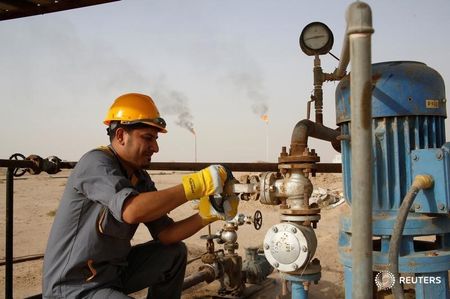Commodities
Oil prices steady at 2-month highs, set for weekly gains

Investing.com — Oil prices steadied Friday, remaining close to two-month highs as optimism over increased summer demand and speculation over supply disruptions offered support.
At 08:00 ET (12:00 GMT), traded 0.2% lower to $87.28 a barrel, while traded largely unchanged at $83.86 a barrel.
Crude prices were headed for a fourth week of strong gains, amid expectations that oil markets will tighten further in the coming months, although trading volumes were muted on account of the U.S. market holiday on Thursday.
Oil heads for weekly gains amid demand optimism
Oil prices were trading up between 2% and 3% this week, having risen sharply amid increasing optimism that crude demand will pick up during the travel-heavy summer season.
U.S. travel demand in particular was a key source of this optimism, as analysts forecast record-high travel activity in the world’s biggest fuel consumer through the independence day week.
Bets on stronger demand were furthered by data showing a massive drawdown in U.S. over the past week, as fuel retailers prepared for holiday travel. This week is also expected to have seen sharp drawdowns in crude inventories.
“Market sentiment has been supported this week by strong mobility indicators and intensifying geopolitical tension in the Middle East,” analysts at ANZ wrote in a note.
Persistent concerns over supply disruptions in the Middle East also saw traders attach a bigger risk premium to oil prices, as tensions between Israel and Lebanon’s Hezbollah showed little signs of easing.
OPEC oversupply, weak economic readings cool oil gains
But whether oil prices will push further remained doubtful, especially as recent data showed members of the Organization of Petroleum Exporting Countries had increased production in recent months, increasing the likelihood that markets become less tight later this year.
Concerns over slowing economic growth in major oil consumers the U.S. and China also remained in play, especially following weak readings on non-manufacturing purchasing managers index data.
Hawkish signals on U.S. interest rates from the Federal Reserve also factored into some market caution, while traders were on edge ahead of key data due later in the day, which is set to provide more cues on the U.S. economy.
Citi revisits its oil forecasts
Geopolitical tensions and extreme weather events remain risks for oil prices in the near term, according to analysts at Citi, in a note, pointing to conflicts in the Middle East and Hurricane Beryl as examples.
However, despite these factors supporting prices in the $80s a barrel currently, Citi sees reasons for a potential softening later in the year.
“Underlying physical market strength looks set to turn softer,” Citi stated, adding that while demand signals are mixed, with some bright spots like higher-than-expected gasoline demand in the US, it remains lower year-over-year.
Citi maintained its 3-month Brent price target of $82 per barrel, but lowered its 6-12 month target to $72 per barrel, citing a potential supply glut post-summer.
(Ambar Warrick contributed to this article.)
Commodities
Oil prices rise; U.S. crude inventories plunge, Russia-Ukraine truce eyed
Commodities
India’s Reliance to stop buying Venezuelan oil over US tariffs, sources say
Commodities
Oil prices climb on Venezuela supply worries

 Forex3 years ago
Forex3 years agoForex Today: the dollar is gaining strength amid gloomy sentiment at the start of the Fed’s week

 Forex3 years ago
Forex3 years agoUnbiased review of Pocket Option broker

 Forex3 years ago
Forex3 years agoDollar to pound sterling exchange rate today: Pound plummeted to its lowest since 1985

 Forex3 years ago
Forex3 years agoHow is the Australian dollar doing today?

 Cryptocurrency3 years ago
Cryptocurrency3 years agoWhat happened in the crypto market – current events today

 World3 years ago
World3 years agoWhy are modern video games an art form?

 Commodities3 years ago
Commodities3 years agoCopper continues to fall in price on expectations of lower demand in China

 Economy3 years ago
Economy3 years agoCrude oil tankers double in price due to EU anti-Russian sanctions























